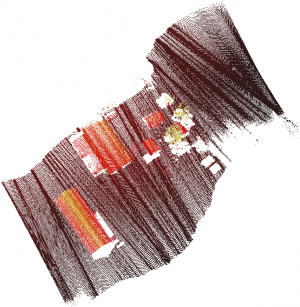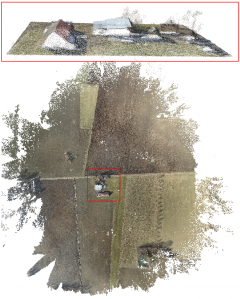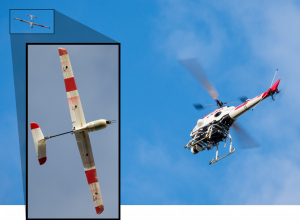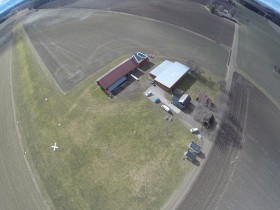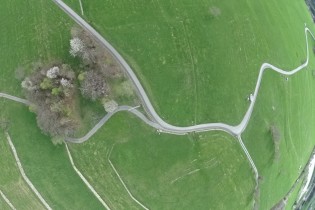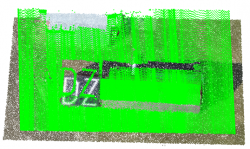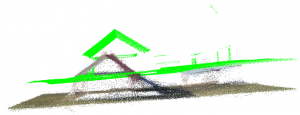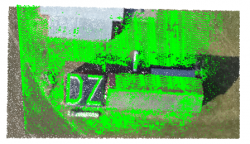Table of Contents
Vision & Laser Datasets From A Heterogeneous UAV Fleet
T. Hinzmann, T. Stastny, G. Conte, P. Doherty, P. Rudol, M. Wzorek, E. Galceran, R. Siegwart, and I. Gilitschenski, Collaborative 3D Reconstruction using Heterogeneous UAVs: System and Experiments. In International Symposium on Experimental Robotics (ISER), 2016, Tokyo, Japan.PDFBibTex
The datasets were collected in Italy and Sweden in the context of a joint mission with the Autonomous Systems Lab, ETH Zurich and the Department of Computer and Information Science, Linköping University; funded by the FP7 EU project SHERPA.
Figure 1: Point cloud generated by the SICK laser scanner from the Rotary-Wing UAV (left) and the vision point cloud generated by the fixed-wing UAV (right).
Employed Platforms & Exteroceptive Sensors
Yamaha RMAX (Rotary-Wing UAV): The Yamaha RMAX helicopter has a rotor diameter of 3.1 m, a maximum take-off weight of 94 kg and a payload capability of about 30 kg. The platform is capable of fully autonomous navigation, including take-off and landing. The basic sensor suite used for autonomous navigation includes a fiber optic tri-axial gyro system and a tri-axial accelerometer system, a RTK GNSS positioning system and an infrared altimeter used for automatic landing.
Techpod (Fixed-Wing UAV): Small unmanned research plane with a classic T-tail configuration, is equipped with one propeller, has a wingspan of 2.60 m and a nominal speed of around 12 m/s. The sensor and processing unit as well as the PX4 auto-pilot are located inside the modified fuselage and allow autonomous mission execution such as GPS waypoint following.
| Platform | Exteroceptive Sensors |
|---|---|
| RMAX | SICK LMS511 PRO 2D laser scanner, maximum range: 80m, maximum scanning FoV: 190° |
| Techpod | Sony ActionCam HDR-AS100V, RGB, rolling shutter, 13 MP; Aptina MT9V034, grayscale, global shutter, 0.3 MP |
Figure 2: The UAV platforms employed for the cooperative scanning missions.
Available Datasets
| Dataset Name | Date (Session) | Location | Sensor | Terrain | Preview | Download |
|---|---|---|---|---|---|---|
| laser_motala_1 | 2015 (I) | Motala, Sweden | SICK | House area | png | laz |
| laser_motala_2 | 2015 (I) | Motala, Sweden | SICK | House area | png | laz |
| laser_motala_3 | 2015 (I) | Motala, Sweden | SICK | House area | png | laz |
| laser_motala_4 | Feb 2016 (II) | Motala, Sweden | SICK | House area | png | laz xyz |
| laser_motala_5 | Feb 2016 (II) | Motala, Sweden | SICK | House area | png | laz |
| laser_motala_6 | Feb 2016 (II) | Motala, Sweden | SICK | House area | png | laz |
| vision_motala_1 | Mar 2016 (III) | Motala, Sweden | Sony | Complete overview | png | laz |
| vision_motala_2 | Mar 2016 (III) | Motala, Sweden | Sony | House area, cropped | png | xyz |
| laser_motala_7 | Mar 2016 (III) | Motala, Sweden | SICK | House area | png | xyz |
| laser_motala_8 | Mar 2016 (III) | Motala, Sweden | SICK | House area | png | xyz |
| laser_motala_9 | Mar 2016 (III) | Motala, Sweden | SICK | House area | png | xyz |
| laser_motala_10 | Mar 2016 (III) | Motala, Sweden | SICK | House area | png | laz |
| vision_isollaz_1 | Apr. 2016 (VI) | Isollaz, Italy | Aptina | Hillside, groves, stone steps, paths | png | laz |
| laser_isollaz_1 | Apr. 2016 (VI) | Isollaz, Italy | SICK | Grove, stone steps, path | png | laz |
| laser_isollaz_2 | Apr. 2016 (VI) | Isollaz, Italy | SICK | Grove, stone steps, path | png | laz |
| laser_isollaz_3 | Apr. 2016 (VI) | Isollaz, Italy | SICK | Grove, stone steps, path | png | laz |
| laser_isollaz_4 | Apr. 2016 (VI) | Isollaz, Italy | SICK | Grove, stone steps, path | png | laz |
Figure 3: Test site near Motala, Sweden (lat/lon: 58.495043/15.102358) and Isollaz, Italy (lat/lon: 45.686922,/7.717967)
Useful Tools
For instance LAStools (in combination with wine on Linux) can be used to view, convert and crop point clouds in .las, .laz and .xyz format.
# view wine LAStools/bin/lasview pointcloud.las # convert wine LAStools/bin/las2las -i input.las -o output.xyz # crop wine LAStools/bin/las2las -i input.xyz -o output.xyz -keep_xy x_min y_min x_max y_max
Source Code
The source code used for aligning a laser and a vision point cloud is available here: Source Code: Robust Point Cloud Registration. The repository contains wrappers for ICP, GICP, NDT as well as the source code for IPDA which is a robust point cloud registration method that uses one-to-many probabilistic data associations (“Robust ICP”).
Figure 4: Misaligned laser point cloud (green) and vision point cloud (colored).
Figure 5: Aligned laser point cloud (green) and vision point cloud (colored) using Robust Point Cloud Registration
